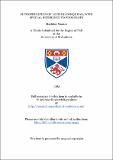Files in this item
Eutrophication of Loch Kilconquhar, with special reference to phosphate
Item metadata
| dc.contributor.advisor | Spence, David Hugh Neven | |
| dc.contributor.author | Mansor, Mashhor | |
| dc.coverage.spatial | 224 p. | en_US |
| dc.date.accessioned | 2018-06-20T13:32:57Z | |
| dc.date.available | 2018-06-20T13:32:57Z | |
| dc.date.issued | 1982 | |
| dc.identifier.uri | https://hdl.handle.net/10023/14345 | |
| dc.description.abstract | This thesis is mainly based on work done in Loch Kilconquhar, Fife, and also to a lesser extent in Loch Lindores, Fife, from March 1979 to March 1981. It discusses the seasonal productivity of the lakes and also the nutrient concentrations, with special reference to phosphate. The overall productivity of phytoplankton in Loch Kilconquhar is high compared with Loch Lindores. The high plankton densities in Loch Kilconquhar during winter were attributed to Diatom species such as Stephanodiscus. Anabaena flos-aquae formed the massive bloom during May 1980 and reached the maximum value of 461.84 +/- 47.02 mg m-2 chlorophyll a in the middle of the month, which was followed by a second blue-green bloom of Aphanizomenon flos-aquae in late summer. The submerged macrophytes such as Myriophyllum spicatum. Zanichellia palustris and Enteromorpha intestinalis grew well on the west side of the loch after the decline of the Anabaena bloom in July 1980, The value of sedimentary chlorophyll reached a maximum of 13.96 +/- 2.04 mg m in late April 1980. The high concentration of Soluble Reactive Phosphate (range: 0.004 - 0.780 mg/l PO4-P) and Nitrate-nitrogen (range: 0.980 - 2.350 mg/l NO3-N) also indicates that Loch Kilconguhar is a nutrient-rich freshwater loch. It is interesting to note that the soluble phosphate is exceptionally high compared with other freshwater lochs in Scotland. There are several possible reasons for this high concentration. Firstly, drainage from an agricultural area may contain much phosphate. However, the inflow in this case has little soluble phosphate but is high in soluble nitrate. Secondly, decomposition of organisms, notably phytoplankton blooms and macrophytes, may contribute to the high concentration of phosphate; these organisms, however, must in turn obtain their phosphorus from water and sediment. The third possibility, and probably the most important, is the nutrient release from the loch sediment. In a laboratory experiment, it was shown that when the dissolved oxygen dropped below 1 mg/1 and the redox potential E7 fell below 240 mVolt, substantial amounts of nutrients, particularly phosphate, were released into the overlying water. The primary source of nutrient in Loch Kilconquhar is the phosphorus-rich excrements of the large wildfowl population and also gulls on the loch. The results show that one g of fresh duck dropping has a mean content of 4170 +/- 350 mg/kg total phosphate and one g of gull dropping has 5072 +/- 748 mg/kg total phosphate. | en_US |
| dc.language.iso | en | en_US |
| dc.publisher | University of St Andrews | |
| dc.subject.lcc | QK753.P6M2 | en |
| dc.subject.lcsh | Plants—Effect of phosphorus on | en |
| dc.title | Eutrophication of Loch Kilconquhar, with special reference to phosphate | en_US |
| dc.type | Thesis | en_US |
| dc.contributor.sponsor | University of Science, Malaysia | en_US |
| dc.type.qualificationlevel | Doctoral | en_US |
| dc.type.qualificationname | PhD Doctor of Philosophy | en_US |
| dc.publisher.institution | The University of St Andrews | en_US |
This item appears in the following Collection(s)
Items in the St Andrews Research Repository are protected by copyright, with all rights reserved, unless otherwise indicated.

